Investigating Design Aspects in Green Commercial Buildings: Proposal
VerifiedAdded on 2023/06/08
|8
|1600
|159
Report
AI Summary
This research proposal explores the design aspects of green commercial buildings, focusing on sustainable development and minimizing environmental impact. It discusses strategies for mitigating environmental impacts during construction, designing effective green building systems, and integrating HVAC systems with a holistic approach to create a sustainable environment. The proposal reviews literature on energy efficiency, resource conservation, and the use of eco-friendly materials, highlighting the importance of considering the entire life-cycle of a building. It also touches upon emerging technologies and design strategies for green HVAC systems, emphasizing the role of these systems in reducing energy consumption and improving indoor air quality. Ultimately, the research aims to provide insights into creating green buildings that are environmentally responsible, cost-effective, and beneficial for occupants.
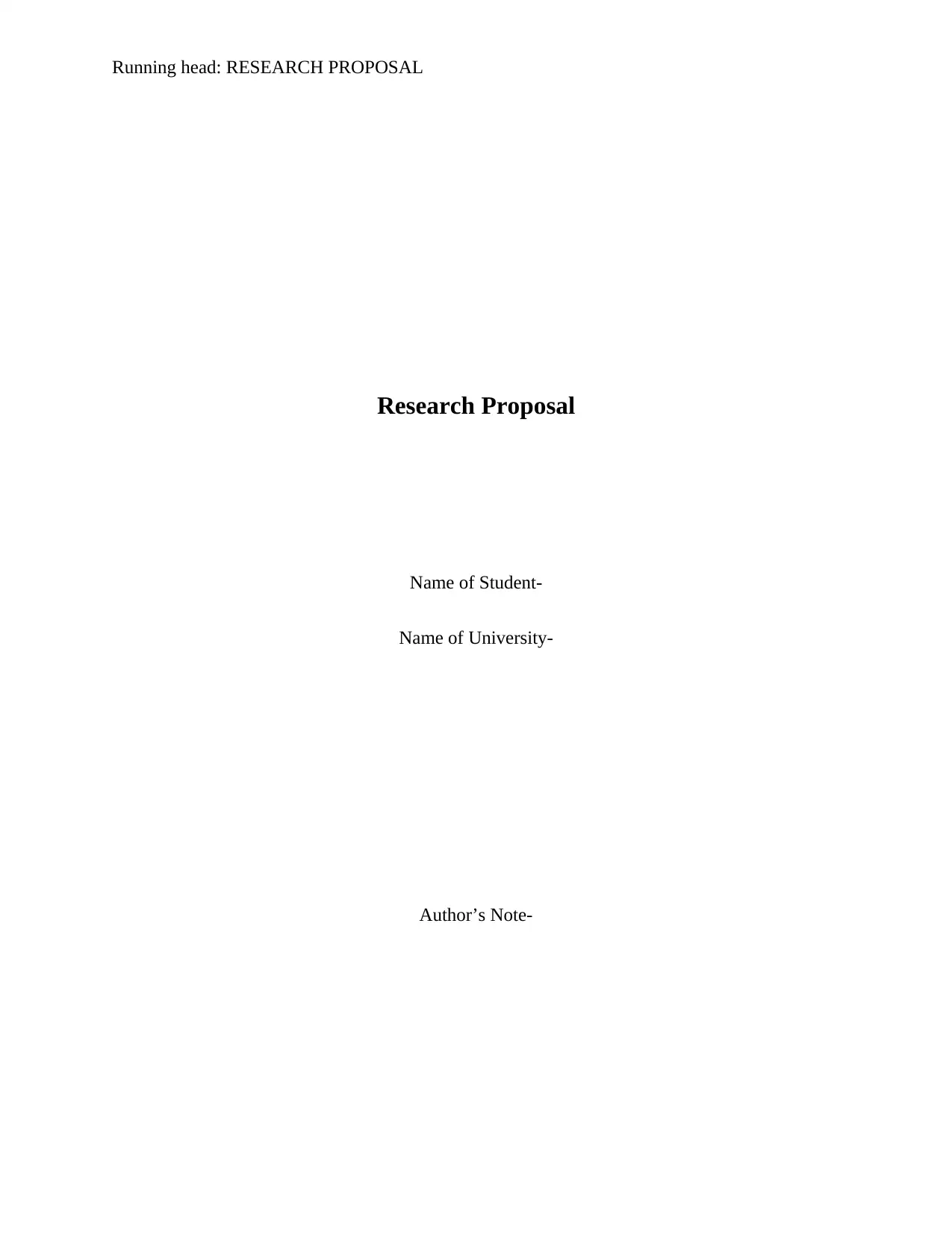
Running head: RESEARCH PROPOSAL
Research Proposal
Name of Student-
Name of University-
Author’s Note-
Research Proposal
Name of Student-
Name of University-
Author’s Note-
Paraphrase This Document
Need a fresh take? Get an instant paraphrase of this document with our AI Paraphraser
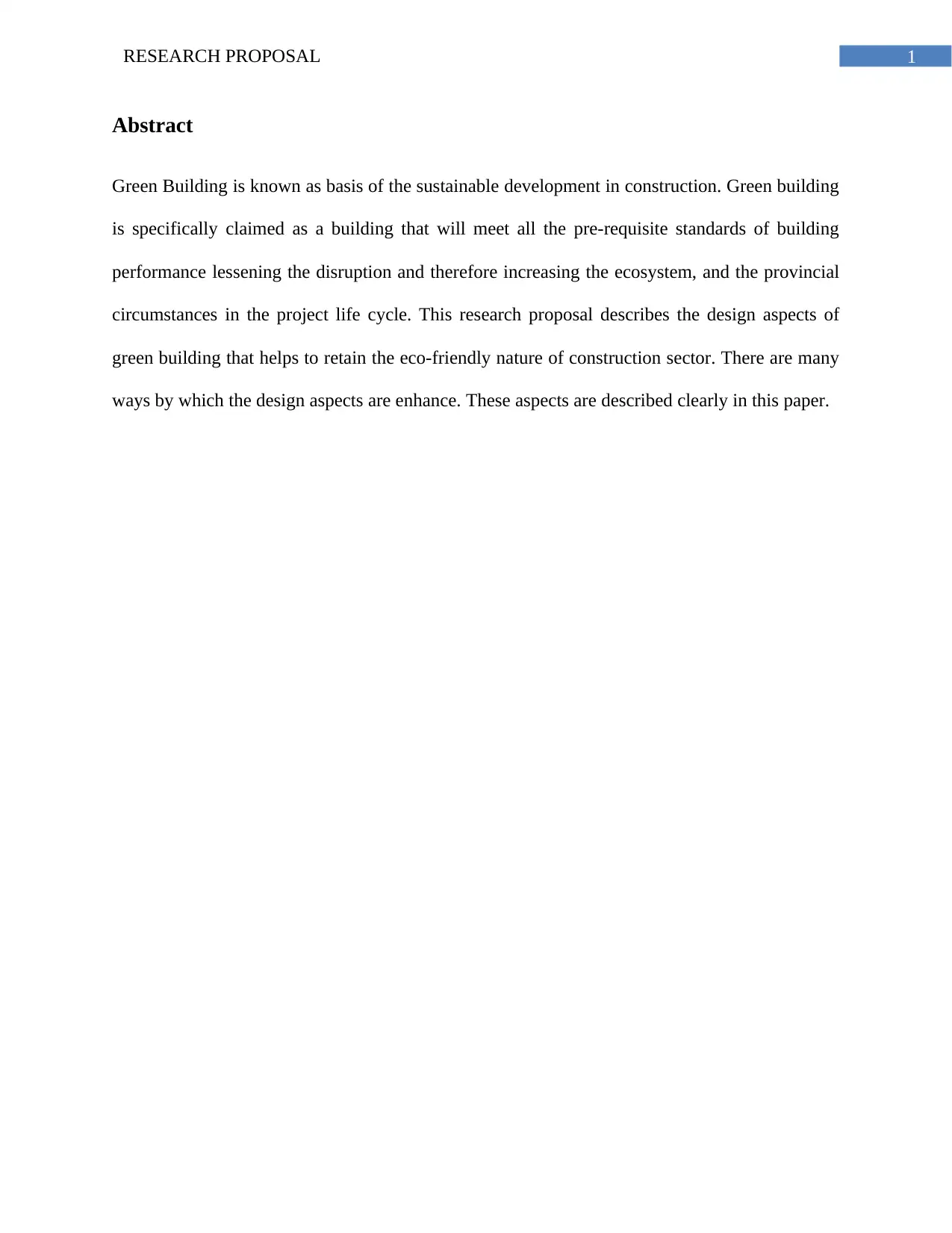
1RESEARCH PROPOSAL
Abstract
Green Building is known as basis of the sustainable development in construction. Green building
is specifically claimed as a building that will meet all the pre-requisite standards of building
performance lessening the disruption and therefore increasing the ecosystem, and the provincial
circumstances in the project life cycle. This research proposal describes the design aspects of
green building that helps to retain the eco-friendly nature of construction sector. There are many
ways by which the design aspects are enhance. These aspects are described clearly in this paper.
Abstract
Green Building is known as basis of the sustainable development in construction. Green building
is specifically claimed as a building that will meet all the pre-requisite standards of building
performance lessening the disruption and therefore increasing the ecosystem, and the provincial
circumstances in the project life cycle. This research proposal describes the design aspects of
green building that helps to retain the eco-friendly nature of construction sector. There are many
ways by which the design aspects are enhance. These aspects are described clearly in this paper.
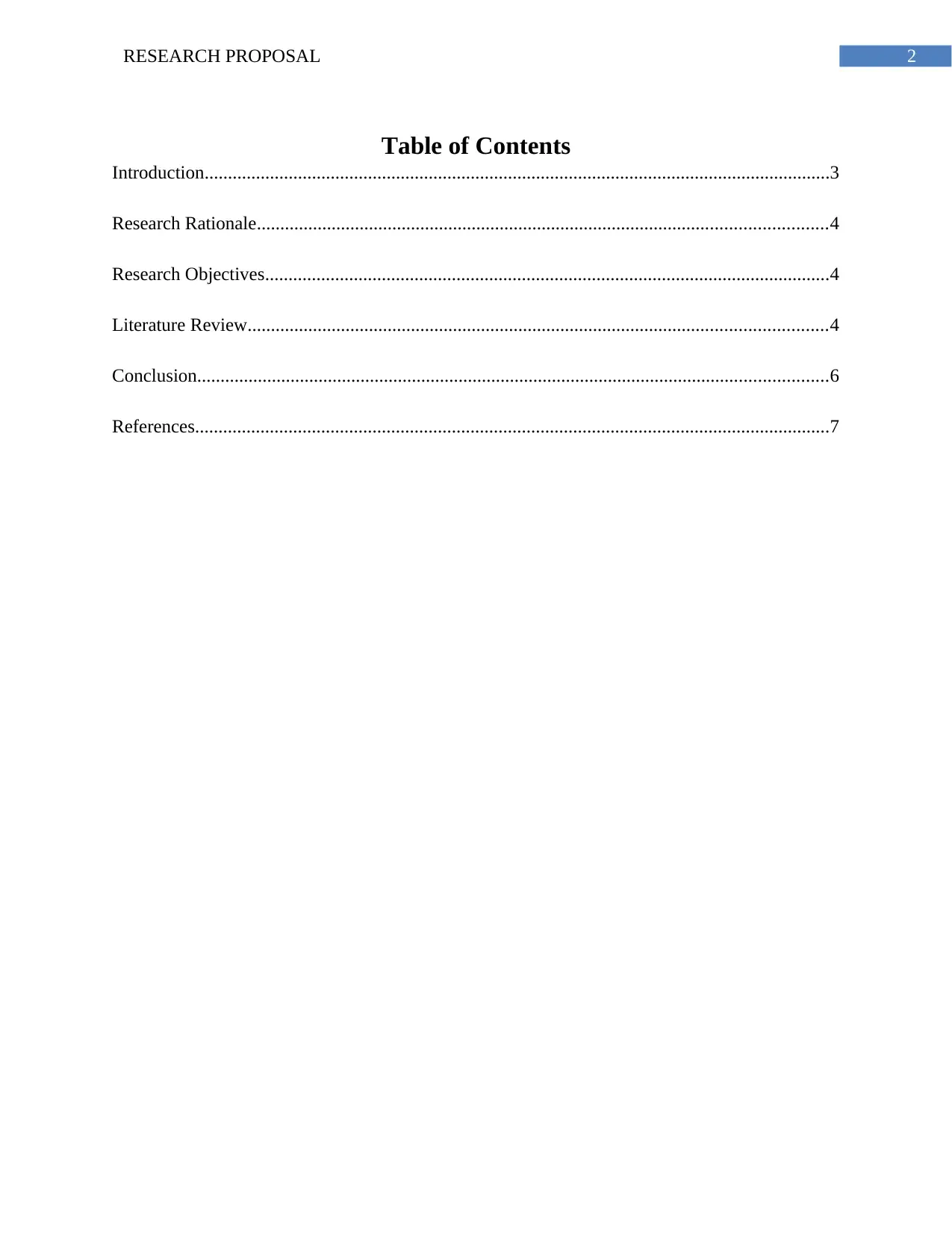
2RESEARCH PROPOSAL
Table of Contents
Introduction......................................................................................................................................3
Research Rationale..........................................................................................................................4
Research Objectives.........................................................................................................................4
Literature Review............................................................................................................................4
Conclusion.......................................................................................................................................6
References........................................................................................................................................7
Table of Contents
Introduction......................................................................................................................................3
Research Rationale..........................................................................................................................4
Research Objectives.........................................................................................................................4
Literature Review............................................................................................................................4
Conclusion.......................................................................................................................................6
References........................................................................................................................................7
⊘ This is a preview!⊘
Do you want full access?
Subscribe today to unlock all pages.

Trusted by 1+ million students worldwide
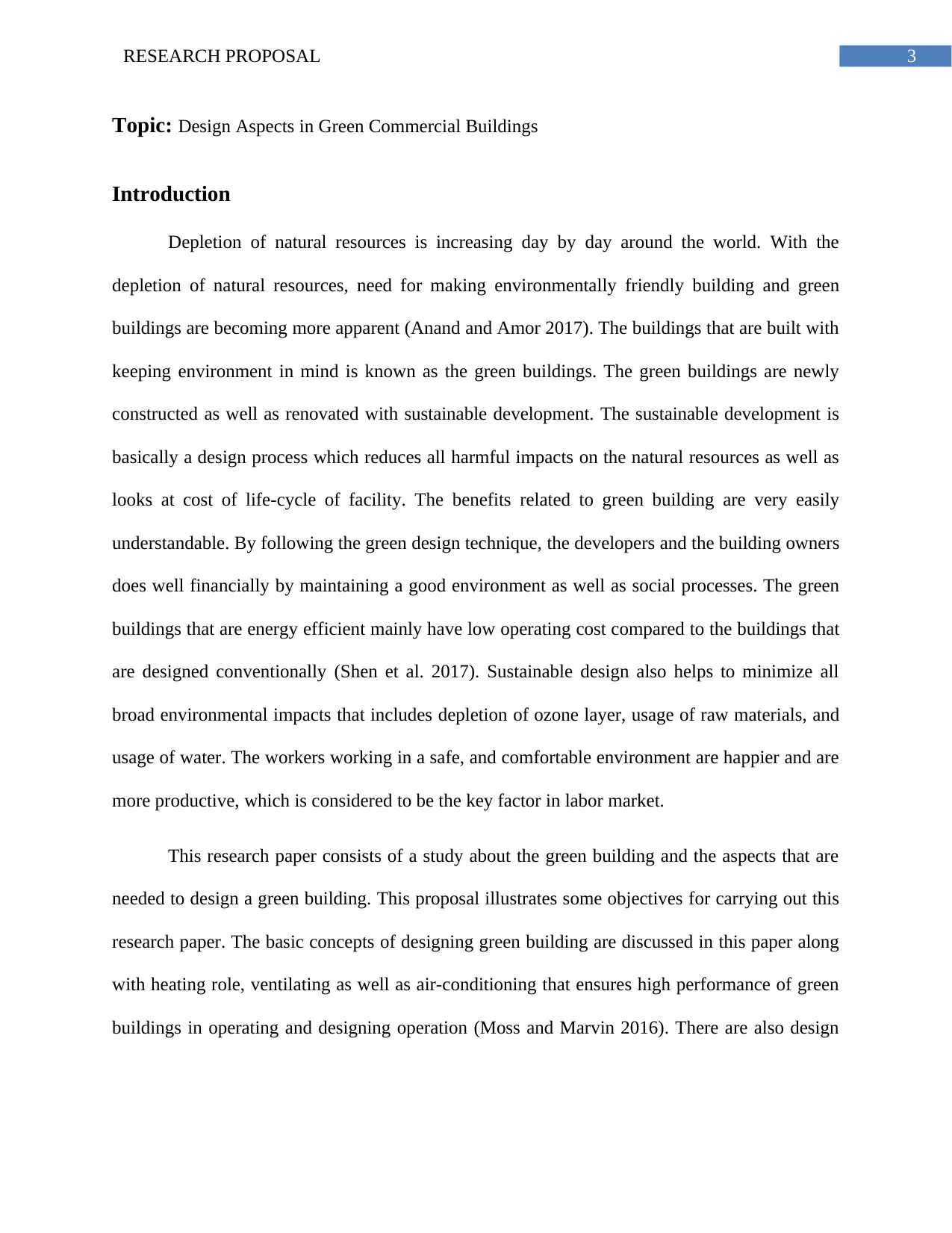
3RESEARCH PROPOSAL
Topic: Design Aspects in Green Commercial Buildings
Introduction
Depletion of natural resources is increasing day by day around the world. With the
depletion of natural resources, need for making environmentally friendly building and green
buildings are becoming more apparent (Anand and Amor 2017). The buildings that are built with
keeping environment in mind is known as the green buildings. The green buildings are newly
constructed as well as renovated with sustainable development. The sustainable development is
basically a design process which reduces all harmful impacts on the natural resources as well as
looks at cost of life-cycle of facility. The benefits related to green building are very easily
understandable. By following the green design technique, the developers and the building owners
does well financially by maintaining a good environment as well as social processes. The green
buildings that are energy efficient mainly have low operating cost compared to the buildings that
are designed conventionally (Shen et al. 2017). Sustainable design also helps to minimize all
broad environmental impacts that includes depletion of ozone layer, usage of raw materials, and
usage of water. The workers working in a safe, and comfortable environment are happier and are
more productive, which is considered to be the key factor in labor market.
This research paper consists of a study about the green building and the aspects that are
needed to design a green building. This proposal illustrates some objectives for carrying out this
research paper. The basic concepts of designing green building are discussed in this paper along
with heating role, ventilating as well as air-conditioning that ensures high performance of green
buildings in operating and designing operation (Moss and Marvin 2016). There are also design
Topic: Design Aspects in Green Commercial Buildings
Introduction
Depletion of natural resources is increasing day by day around the world. With the
depletion of natural resources, need for making environmentally friendly building and green
buildings are becoming more apparent (Anand and Amor 2017). The buildings that are built with
keeping environment in mind is known as the green buildings. The green buildings are newly
constructed as well as renovated with sustainable development. The sustainable development is
basically a design process which reduces all harmful impacts on the natural resources as well as
looks at cost of life-cycle of facility. The benefits related to green building are very easily
understandable. By following the green design technique, the developers and the building owners
does well financially by maintaining a good environment as well as social processes. The green
buildings that are energy efficient mainly have low operating cost compared to the buildings that
are designed conventionally (Shen et al. 2017). Sustainable design also helps to minimize all
broad environmental impacts that includes depletion of ozone layer, usage of raw materials, and
usage of water. The workers working in a safe, and comfortable environment are happier and are
more productive, which is considered to be the key factor in labor market.
This research paper consists of a study about the green building and the aspects that are
needed to design a green building. This proposal illustrates some objectives for carrying out this
research paper. The basic concepts of designing green building are discussed in this paper along
with heating role, ventilating as well as air-conditioning that ensures high performance of green
buildings in operating and designing operation (Moss and Marvin 2016). There are also design
Paraphrase This Document
Need a fresh take? Get an instant paraphrase of this document with our AI Paraphraser
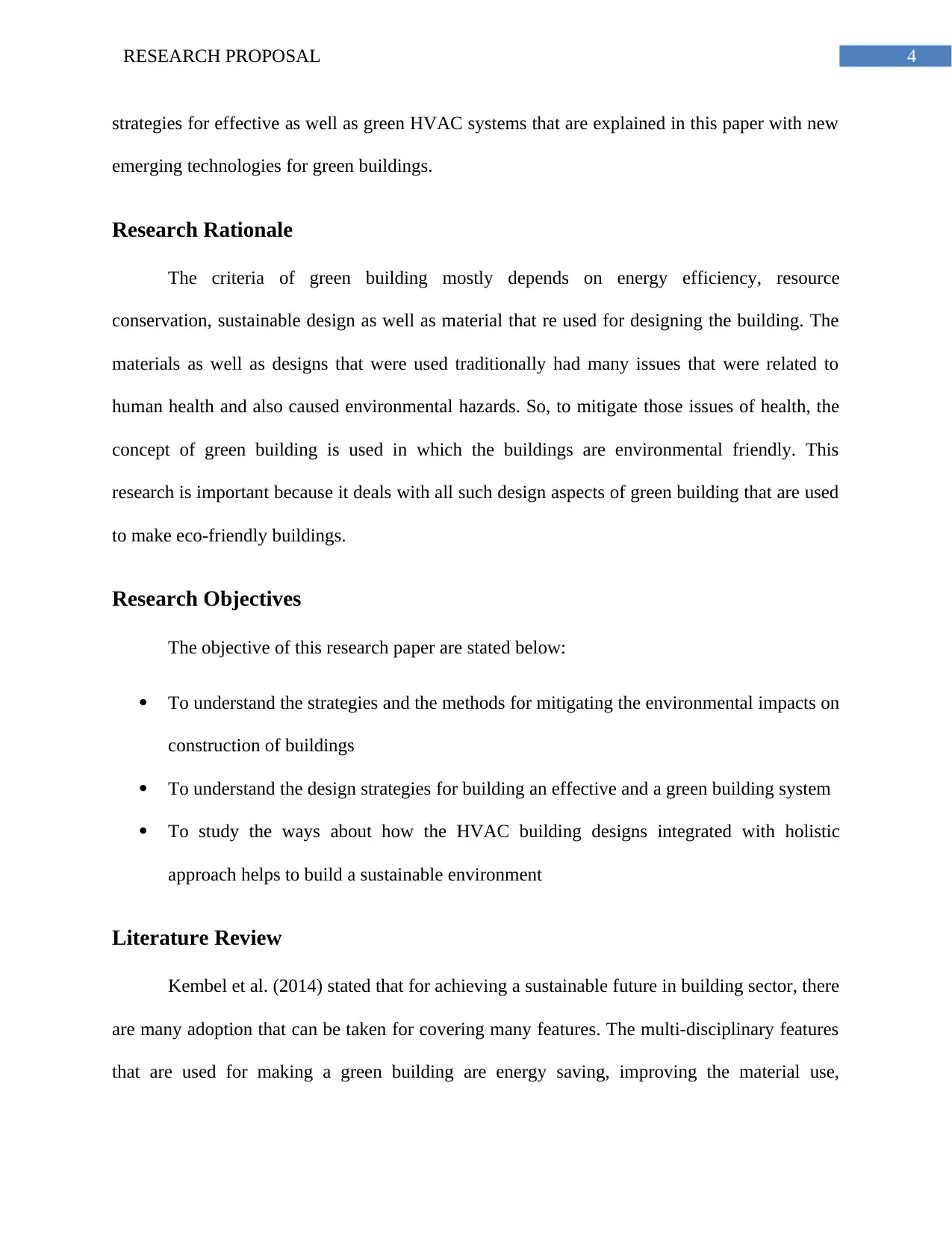
4RESEARCH PROPOSAL
strategies for effective as well as green HVAC systems that are explained in this paper with new
emerging technologies for green buildings.
Research Rationale
The criteria of green building mostly depends on energy efficiency, resource
conservation, sustainable design as well as material that re used for designing the building. The
materials as well as designs that were used traditionally had many issues that were related to
human health and also caused environmental hazards. So, to mitigate those issues of health, the
concept of green building is used in which the buildings are environmental friendly. This
research is important because it deals with all such design aspects of green building that are used
to make eco-friendly buildings.
Research Objectives
The objective of this research paper are stated below:
To understand the strategies and the methods for mitigating the environmental impacts on
construction of buildings
To understand the design strategies for building an effective and a green building system
To study the ways about how the HVAC building designs integrated with holistic
approach helps to build a sustainable environment
Literature Review
Kembel et al. (2014) stated that for achieving a sustainable future in building sector, there
are many adoption that can be taken for covering many features. The multi-disciplinary features
that are used for making a green building are energy saving, improving the material use,
strategies for effective as well as green HVAC systems that are explained in this paper with new
emerging technologies for green buildings.
Research Rationale
The criteria of green building mostly depends on energy efficiency, resource
conservation, sustainable design as well as material that re used for designing the building. The
materials as well as designs that were used traditionally had many issues that were related to
human health and also caused environmental hazards. So, to mitigate those issues of health, the
concept of green building is used in which the buildings are environmental friendly. This
research is important because it deals with all such design aspects of green building that are used
to make eco-friendly buildings.
Research Objectives
The objective of this research paper are stated below:
To understand the strategies and the methods for mitigating the environmental impacts on
construction of buildings
To understand the design strategies for building an effective and a green building system
To study the ways about how the HVAC building designs integrated with holistic
approach helps to build a sustainable environment
Literature Review
Kembel et al. (2014) stated that for achieving a sustainable future in building sector, there
are many adoption that can be taken for covering many features. The multi-disciplinary features
that are used for making a green building are energy saving, improving the material use,
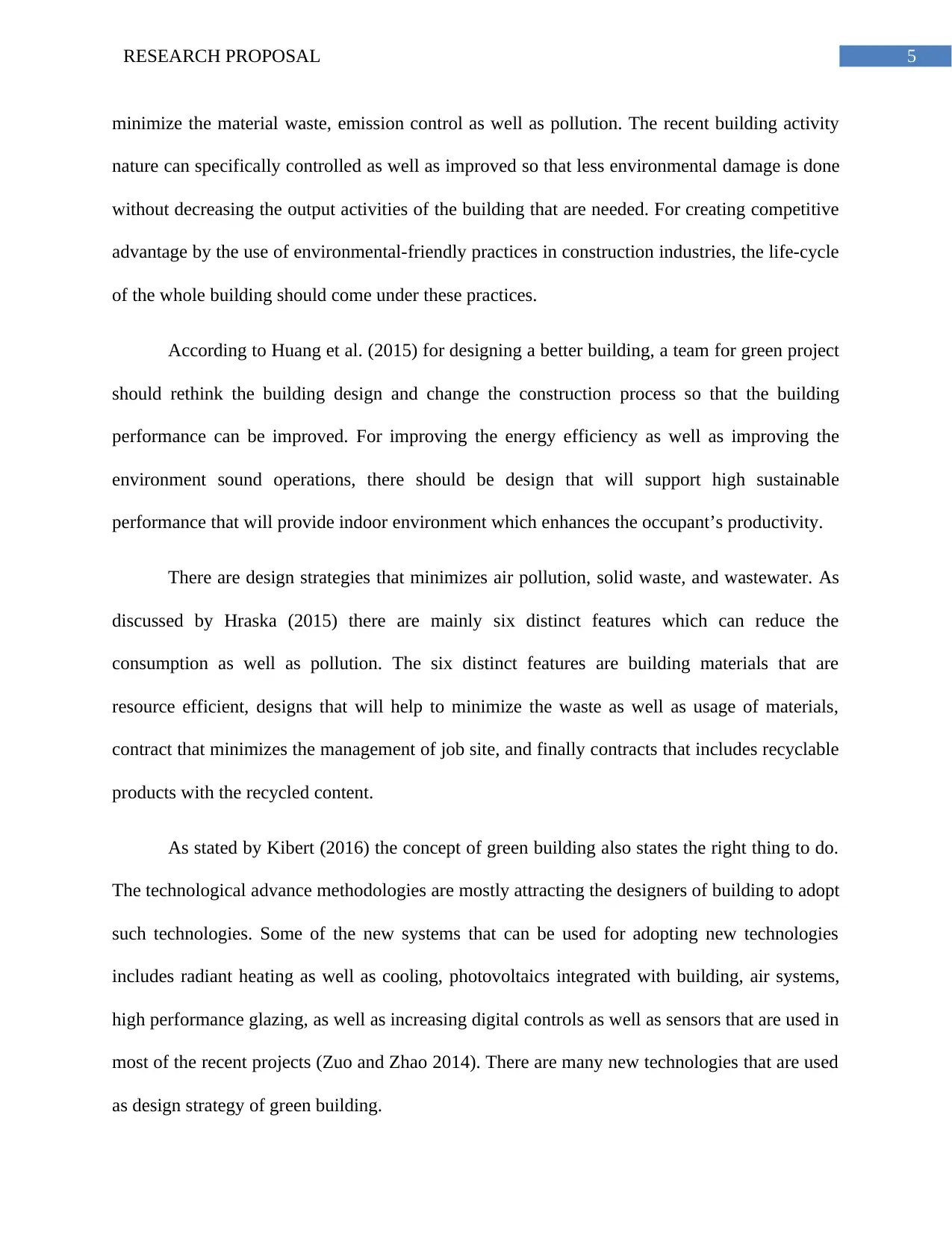
5RESEARCH PROPOSAL
minimize the material waste, emission control as well as pollution. The recent building activity
nature can specifically controlled as well as improved so that less environmental damage is done
without decreasing the output activities of the building that are needed. For creating competitive
advantage by the use of environmental-friendly practices in construction industries, the life-cycle
of the whole building should come under these practices.
According to Huang et al. (2015) for designing a better building, a team for green project
should rethink the building design and change the construction process so that the building
performance can be improved. For improving the energy efficiency as well as improving the
environment sound operations, there should be design that will support high sustainable
performance that will provide indoor environment which enhances the occupant’s productivity.
There are design strategies that minimizes air pollution, solid waste, and wastewater. As
discussed by Hraska (2015) there are mainly six distinct features which can reduce the
consumption as well as pollution. The six distinct features are building materials that are
resource efficient, designs that will help to minimize the waste as well as usage of materials,
contract that minimizes the management of job site, and finally contracts that includes recyclable
products with the recycled content.
As stated by Kibert (2016) the concept of green building also states the right thing to do.
The technological advance methodologies are mostly attracting the designers of building to adopt
such technologies. Some of the new systems that can be used for adopting new technologies
includes radiant heating as well as cooling, photovoltaics integrated with building, air systems,
high performance glazing, as well as increasing digital controls as well as sensors that are used in
most of the recent projects (Zuo and Zhao 2014). There are many new technologies that are used
as design strategy of green building.
minimize the material waste, emission control as well as pollution. The recent building activity
nature can specifically controlled as well as improved so that less environmental damage is done
without decreasing the output activities of the building that are needed. For creating competitive
advantage by the use of environmental-friendly practices in construction industries, the life-cycle
of the whole building should come under these practices.
According to Huang et al. (2015) for designing a better building, a team for green project
should rethink the building design and change the construction process so that the building
performance can be improved. For improving the energy efficiency as well as improving the
environment sound operations, there should be design that will support high sustainable
performance that will provide indoor environment which enhances the occupant’s productivity.
There are design strategies that minimizes air pollution, solid waste, and wastewater. As
discussed by Hraska (2015) there are mainly six distinct features which can reduce the
consumption as well as pollution. The six distinct features are building materials that are
resource efficient, designs that will help to minimize the waste as well as usage of materials,
contract that minimizes the management of job site, and finally contracts that includes recyclable
products with the recycled content.
As stated by Kibert (2016) the concept of green building also states the right thing to do.
The technological advance methodologies are mostly attracting the designers of building to adopt
such technologies. Some of the new systems that can be used for adopting new technologies
includes radiant heating as well as cooling, photovoltaics integrated with building, air systems,
high performance glazing, as well as increasing digital controls as well as sensors that are used in
most of the recent projects (Zuo and Zhao 2014). There are many new technologies that are used
as design strategy of green building.
⊘ This is a preview!⊘
Do you want full access?
Subscribe today to unlock all pages.

Trusted by 1+ million students worldwide
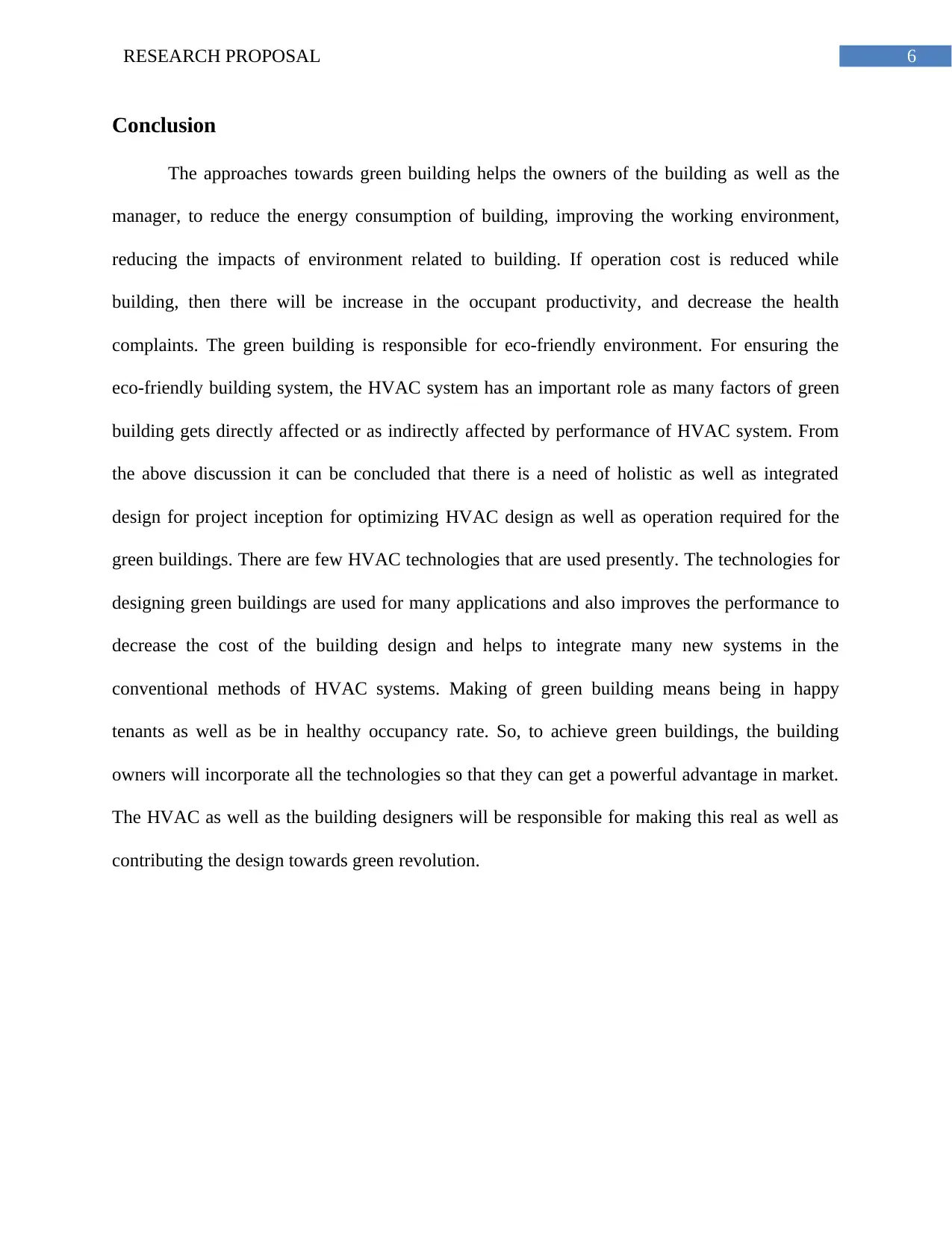
6RESEARCH PROPOSAL
Conclusion
The approaches towards green building helps the owners of the building as well as the
manager, to reduce the energy consumption of building, improving the working environment,
reducing the impacts of environment related to building. If operation cost is reduced while
building, then there will be increase in the occupant productivity, and decrease the health
complaints. The green building is responsible for eco-friendly environment. For ensuring the
eco-friendly building system, the HVAC system has an important role as many factors of green
building gets directly affected or as indirectly affected by performance of HVAC system. From
the above discussion it can be concluded that there is a need of holistic as well as integrated
design for project inception for optimizing HVAC design as well as operation required for the
green buildings. There are few HVAC technologies that are used presently. The technologies for
designing green buildings are used for many applications and also improves the performance to
decrease the cost of the building design and helps to integrate many new systems in the
conventional methods of HVAC systems. Making of green building means being in happy
tenants as well as be in healthy occupancy rate. So, to achieve green buildings, the building
owners will incorporate all the technologies so that they can get a powerful advantage in market.
The HVAC as well as the building designers will be responsible for making this real as well as
contributing the design towards green revolution.
Conclusion
The approaches towards green building helps the owners of the building as well as the
manager, to reduce the energy consumption of building, improving the working environment,
reducing the impacts of environment related to building. If operation cost is reduced while
building, then there will be increase in the occupant productivity, and decrease the health
complaints. The green building is responsible for eco-friendly environment. For ensuring the
eco-friendly building system, the HVAC system has an important role as many factors of green
building gets directly affected or as indirectly affected by performance of HVAC system. From
the above discussion it can be concluded that there is a need of holistic as well as integrated
design for project inception for optimizing HVAC design as well as operation required for the
green buildings. There are few HVAC technologies that are used presently. The technologies for
designing green buildings are used for many applications and also improves the performance to
decrease the cost of the building design and helps to integrate many new systems in the
conventional methods of HVAC systems. Making of green building means being in happy
tenants as well as be in healthy occupancy rate. So, to achieve green buildings, the building
owners will incorporate all the technologies so that they can get a powerful advantage in market.
The HVAC as well as the building designers will be responsible for making this real as well as
contributing the design towards green revolution.
Paraphrase This Document
Need a fresh take? Get an instant paraphrase of this document with our AI Paraphraser
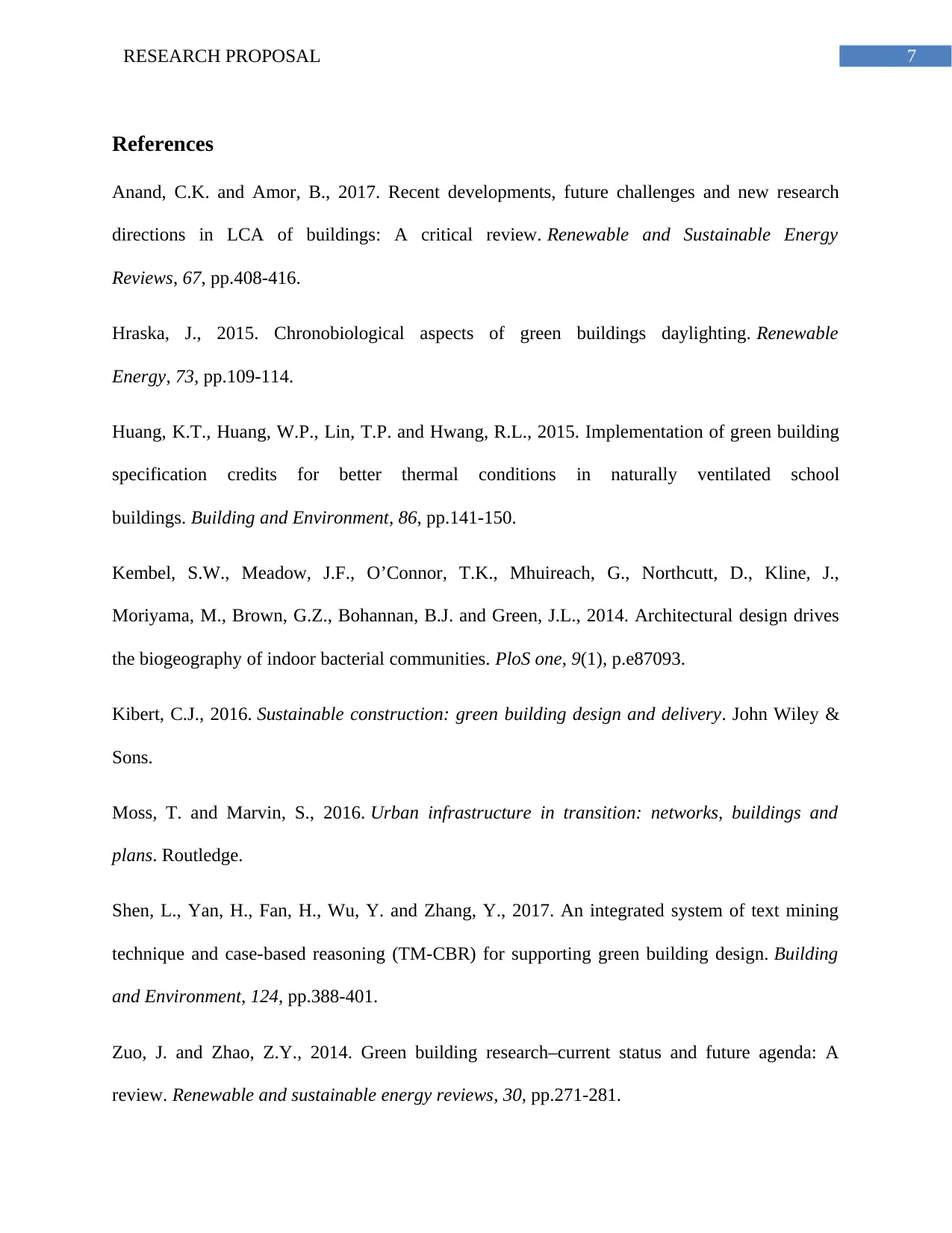
7RESEARCH PROPOSAL
References
Anand, C.K. and Amor, B., 2017. Recent developments, future challenges and new research
directions in LCA of buildings: A critical review. Renewable and Sustainable Energy
Reviews, 67, pp.408-416.
Hraska, J., 2015. Chronobiological aspects of green buildings daylighting. Renewable
Energy, 73, pp.109-114.
Huang, K.T., Huang, W.P., Lin, T.P. and Hwang, R.L., 2015. Implementation of green building
specification credits for better thermal conditions in naturally ventilated school
buildings. Building and Environment, 86, pp.141-150.
Kembel, S.W., Meadow, J.F., O’Connor, T.K., Mhuireach, G., Northcutt, D., Kline, J.,
Moriyama, M., Brown, G.Z., Bohannan, B.J. and Green, J.L., 2014. Architectural design drives
the biogeography of indoor bacterial communities. PloS one, 9(1), p.e87093.
Kibert, C.J., 2016. Sustainable construction: green building design and delivery. John Wiley &
Sons.
Moss, T. and Marvin, S., 2016. Urban infrastructure in transition: networks, buildings and
plans. Routledge.
Shen, L., Yan, H., Fan, H., Wu, Y. and Zhang, Y., 2017. An integrated system of text mining
technique and case-based reasoning (TM-CBR) for supporting green building design. Building
and Environment, 124, pp.388-401.
Zuo, J. and Zhao, Z.Y., 2014. Green building research–current status and future agenda: A
review. Renewable and sustainable energy reviews, 30, pp.271-281.
References
Anand, C.K. and Amor, B., 2017. Recent developments, future challenges and new research
directions in LCA of buildings: A critical review. Renewable and Sustainable Energy
Reviews, 67, pp.408-416.
Hraska, J., 2015. Chronobiological aspects of green buildings daylighting. Renewable
Energy, 73, pp.109-114.
Huang, K.T., Huang, W.P., Lin, T.P. and Hwang, R.L., 2015. Implementation of green building
specification credits for better thermal conditions in naturally ventilated school
buildings. Building and Environment, 86, pp.141-150.
Kembel, S.W., Meadow, J.F., O’Connor, T.K., Mhuireach, G., Northcutt, D., Kline, J.,
Moriyama, M., Brown, G.Z., Bohannan, B.J. and Green, J.L., 2014. Architectural design drives
the biogeography of indoor bacterial communities. PloS one, 9(1), p.e87093.
Kibert, C.J., 2016. Sustainable construction: green building design and delivery. John Wiley &
Sons.
Moss, T. and Marvin, S., 2016. Urban infrastructure in transition: networks, buildings and
plans. Routledge.
Shen, L., Yan, H., Fan, H., Wu, Y. and Zhang, Y., 2017. An integrated system of text mining
technique and case-based reasoning (TM-CBR) for supporting green building design. Building
and Environment, 124, pp.388-401.
Zuo, J. and Zhao, Z.Y., 2014. Green building research–current status and future agenda: A
review. Renewable and sustainable energy reviews, 30, pp.271-281.
1 out of 8
Related Documents
Your All-in-One AI-Powered Toolkit for Academic Success.
+13062052269
info@desklib.com
Available 24*7 on WhatsApp / Email
![[object Object]](/_next/static/media/star-bottom.7253800d.svg)
Unlock your academic potential
Copyright © 2020–2025 A2Z Services. All Rights Reserved. Developed and managed by ZUCOL.





